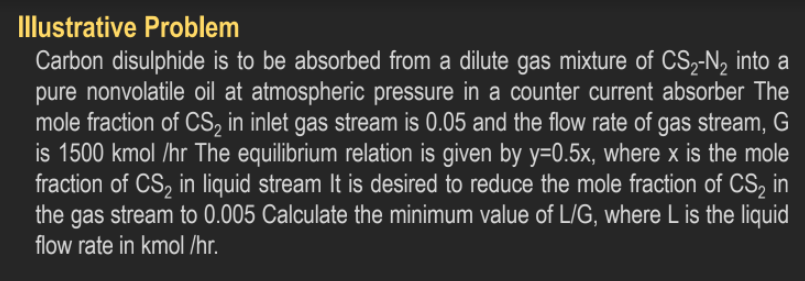Carbon disulphide is to be absorbed from a dilute gas mixture of CS2-N2 into a pure nonvolatile oil at atmospheric pressure in a counter current absorber The mole fraction of CS, in inlet gas stream is 0.05 and the flow rate of gas stream, G is 1500 kmol /hr The equilibrium relation is given by y=0.5x, where x is the mole fraction of CS, in liquid stream It is desired to reduce the mole fraction of CS, in the gas stream to 0.005 Calculate the minimum value of L/G, where L is the liquid flow rate in kmol /hr.
Carbon disulphide is to be absorbed from a dilute gas mixture of CS2-N2 into a pure nonvolatile oil at atmospheric pressure in a counter current absorber The mole fraction of CS, in inlet gas stream is 0.05 and the flow rate of gas stream, G is 1500 kmol /hr The equilibrium relation is given by y=0.5x, where x is the mole fraction of CS, in liquid stream It is desired to reduce the mole fraction of CS, in the gas stream to 0.005 Calculate the minimum value of L/G, where L is the liquid flow rate in kmol /hr.
Introduction to Chemical Engineering Thermodynamics
8th Edition
ISBN:9781259696527
Author:J.M. Smith Termodinamica en ingenieria quimica, Hendrick C Van Ness, Michael Abbott, Mark Swihart
Publisher:J.M. Smith Termodinamica en ingenieria quimica, Hendrick C Van Ness, Michael Abbott, Mark Swihart
Chapter1: Introduction
Section: Chapter Questions
Problem 1.1P
Related questions
Question

Transcribed Image Text:Illustrative Problem
Carbon disulphide is to be absorbed from a dilute gas mixture of CS2-N2 into a
pure nonvolatile oil at atmospheric pressure in a counter current absorber The
mole fraction of CS, in inlet gas stream is 0.05 and the flow rate of gas stream, G
is 1500 kmol /hr The equilibrium relation is given by y=0.5x, where x is the mole
fraction of CS, in liquid stream It is desired to reduce the mole fraction of CS, in
the gas stream to 0.005 Calculate the minimum value of L/G, where L is the liquid
flow rate in kmol /hr.
Expert Solution
This question has been solved!
Explore an expertly crafted, step-by-step solution for a thorough understanding of key concepts.
Step by step
Solved in 3 steps with 1 images

Recommended textbooks for you

Introduction to Chemical Engineering Thermodynami…
Chemical Engineering
ISBN:
9781259696527
Author:
J.M. Smith Termodinamica en ingenieria quimica, Hendrick C Van Ness, Michael Abbott, Mark Swihart
Publisher:
McGraw-Hill Education

Elementary Principles of Chemical Processes, Bind…
Chemical Engineering
ISBN:
9781118431221
Author:
Richard M. Felder, Ronald W. Rousseau, Lisa G. Bullard
Publisher:
WILEY

Elements of Chemical Reaction Engineering (5th Ed…
Chemical Engineering
ISBN:
9780133887518
Author:
H. Scott Fogler
Publisher:
Prentice Hall

Introduction to Chemical Engineering Thermodynami…
Chemical Engineering
ISBN:
9781259696527
Author:
J.M. Smith Termodinamica en ingenieria quimica, Hendrick C Van Ness, Michael Abbott, Mark Swihart
Publisher:
McGraw-Hill Education

Elementary Principles of Chemical Processes, Bind…
Chemical Engineering
ISBN:
9781118431221
Author:
Richard M. Felder, Ronald W. Rousseau, Lisa G. Bullard
Publisher:
WILEY

Elements of Chemical Reaction Engineering (5th Ed…
Chemical Engineering
ISBN:
9780133887518
Author:
H. Scott Fogler
Publisher:
Prentice Hall


Industrial Plastics: Theory and Applications
Chemical Engineering
ISBN:
9781285061238
Author:
Lokensgard, Erik
Publisher:
Delmar Cengage Learning

Unit Operations of Chemical Engineering
Chemical Engineering
ISBN:
9780072848236
Author:
Warren McCabe, Julian C. Smith, Peter Harriott
Publisher:
McGraw-Hill Companies, The